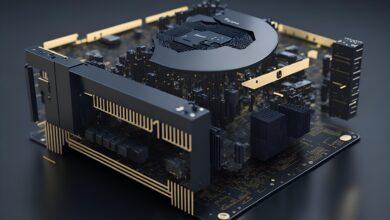Build Your Own Crypto Mining Rig Today!

In the ever-evolving landscape of digital currencies, the allure of cryptocurrency mining has captured the imaginations of enthusiasts and investors alike. The prospect of creating your own personal mining rig offers not only the thrill of participation in this revolutionary financial ecosystem but also the potential for tangible rewards. This comprehensive guide aims to illuminate the intricate process of assembling a cryptocurrency mining setup, providing detailed instructions that cater to both novices and seasoned tech aficionados.
Building your own crypto mining machine is not merely a technical endeavor; it is an exciting journey into the heart of decentralized finance. With each component selected and connected, you are not just creating a setup; you are forging a connection with a global network that values transparency and innovation. This tutorial will walk you through every step required to create an efficient and effective mining rig, ensuring that your experience is as rewarding as the potential profits it may yield.
As we delve into the specifics of how to assemble your rig, we will cover essential hardware choices, software configurations, and best practices for optimizing performance. Each section of this guide is designed to be clear and actionable, providing you with the necessary insights to navigate any challenges you may encounter along the way. By the end of this journey, you will not only have a fully operational cryptocurrency mining setup but also a deeper understanding of the technology that underpins this fascinating field.
Let us embark on this adventure together, as we explore the art and science of creating your very own cryptocurrency mining rig, equipped with the knowledge and tools needed to thrive in this dynamic digital frontier.
How to Set Up Your Own Cryptocurrency Mining Rig: A Step-by-Step Guide
Creating your own cryptocurrency mining rig can be an exhilarating journey into the world of digital assets. To embark on this venture, one must first understand what a mining rig is: a specialized machine designed to solve complex mathematical problems that validate transactions on the blockchain. This comprehensive guide will provide detailed instructions and a step-by-step tutorial for assembling your personal crypto mining setup, ensuring you are well-equipped to navigate each stage of the process.
The first crucial step in building your own mining machine is choosing the right hardware. The quintessential components include a powerful graphics processing unit (GPU), a robust motherboard, sufficient RAM, and an efficient power supply unit (PSU). For instance, GPUs from manufacturers like NVIDIA and AMD are widely regarded as the best options for crypto mining due to their high hash rates. It’s essential to research current market conditions and select the components that align with your budget and mining goals.
Once you’ve gathered all necessary parts, the assembly phase begins. This involves physically putting together the machine: connecting the motherboard to the PSU, installing GPUs into PCIe slots, and ensuring proper cooling systems are in place to prevent overheating during operation. Following detailed instructions from reliable sources can simplify this process significantly. Remember, proper cable management not only enhances aesthetic appeal but also improves airflow within your rig–a critical factor in maintaining optimal performance.
With your mining rig assembled, the next step is setting up software that facilitates cryptocurrency mining. This typically includes selecting a mining pool–groups of miners that collaborate to increase their chances of earning rewards–and downloading relevant mining software tailored to your chosen cryptocurrency. A popular choice is CGMiner for Bitcoin or Ethminer for Ethereum. Each program comes with unique features and configurations; thus, it’s important to follow specific setup tutorials for these applications to maximize efficiency.
After successfully configuring your software, it’s time to delve into the intricacies of optimization. Fine-tuning settings such as clock speeds, fan speeds, and voltage can yield significant gains in performance and profitability. Utilizing benchmarking tools enables you to assess how effectively your rig operates under various conditions. As you create your own personalized strategies for managing heat output and power consumption, you’ll develop a more profound understanding of how these variables impact your overall mining success.
Finally, maintaining your cryptocurrency mining rig is paramount for longevity and profitability. Regular monitoring of hardware metrics through dedicated applications ensures you are alerted to any irregularities or potential failures. Additionally, staying informed about updates in mining algorithms or shifts in cryptocurrency markets will empower you to adapt your strategies accordingly. By following this detailed guide on setting up and optimizing your own crypto mining rig, you’ll be well-positioned to thrive in this dynamic digital landscape.
Choosing the Right Hardware for Your Crypto Mining Rig
In the intricate dance of cryptocurrency mining, the choice of hardware stands as a pivotal first step in your journey. The right setup can mean the difference between a profitable venture and a costly misadventure. When you decide to create your own mining rig, it’s essential to understand the components that will comprise your machine. You’ll need to consider factors such as processing power, energy efficiency, and initial costs. This guide will assist you in navigating these complexities with a step-by-step approach tailored for budding miners.
To begin assembling your personal mining setup, you’ll first want to select an appropriate graphics processing unit (GPU). Modern cryptocurrencies often rely on GPUs for their superior parallel processing capabilities over traditional CPUs. Research has shown that certain models yield higher hash rates while consuming less power. For instance, NVIDIA’s RTX series or AMD’s Radeon RX line have proven to be popular among miners due to their balance of performance and energy consumption. A careful analysis of current market trends and mining benchmarks will aid in making an informed choice that aligns with your financial constraints.
Once you’ve settled on a GPU, the next step is to identify a compatible motherboard. This component must support multiple GPUs if you wish to expand your rig in the future. A motherboard with ample PCIe slots is essential for scalability. Additionally, ensure that it possesses sufficient RAM and supports the necessary connectivity options for your mining rig. A detailed examination of product specifications will be invaluable here; manufacturers often provide insights into compatibility with various GPU models.
Next on the agenda is selecting a power supply unit (PSU) that can handle the collective wattage demands of your chosen components. An underpowered PSU can lead to system instability and ultimately jeopardize your mining efforts. Aim for a high-efficiency rating–preferably 80 PLUS Gold or Platinum–to maximize power usage while minimizing heat generation. As you move forward, calculate the total wattage requirement of your rig, including headroom for potential upgrades, ensuring that your PSU choice aligns with these figures.
After acquiring all necessary components, the assembly process begins–a crucial phase requiring diligence and precision. Follow detailed instructions available from reputable sources or community forums dedicated to cryptocurrency mining. Start by mounting the motherboard inside the chosen case, securing it properly before attaching the CPU and cooler. Next, install your GPUs into the available PCIe slots, ensuring they are firmly seated to avoid connection issues during operation. Wiring can seem daunting; however, methodical organization of cables will facilitate airflow and maintain an orderly setup.
Finally, once your mining machine is fully assembled, it’s time to configure software settings tailored for optimal performance. Install a suitable operating system–many miners prefer Linux for its resource efficiency–followed by mining software compatible with your chosen cryptocurrency. It’s crucial to stay updated on software versions and miner configurations to maximize efficiency continually. With this comprehensive guide in hand, you are now equipped with the knowledge needed to embark on your crypto mining journey, crafting a machine designed not just for today but for future possibilities as well.
Installing Mining Software: A Step-by-Step Tutorial for Creating Your Own Crypto Mining Rig
Creating your own cryptocurrency mining rig requires not only physical assembly but also the installation of specialized mining software. This guide aims to provide a comprehensive overview of how to set up your own mining machine, detailing each step to ensure a seamless experience. The first crucial step involves selecting the appropriate mining software compatible with your hardware and the cryptocurrency you intend to mine. Popular choices include CGMiner, BFGMiner, and EasyMiner, each offering unique features tailored for specific setups.
Once you have chosen the software, the next phase is to download and install it on your system. For Windows users, this typically involves downloading an executable file from the official website of the software provider. In contrast, Linux users may need to compile the software from source code, which entails a deeper understanding of command-line operations. Follow the detailed instructions provided by the software developers carefully to avoid common pitfalls that could hinder your mining efforts.
After successful installation, it’s time to configure your mining software for optimal performance. This setup includes entering your wallet address–where your mined cryptocurrency will be deposited–and selecting a mining pool if you choose to collaborate with other miners. Pools often provide better odds of earning rewards compared to solo mining, especially in highly competitive environments. Ensure that you understand how to navigate the configuration files or GUI settings specific to your chosen software, as this will significantly affect your rig’s efficiency.
Finally, once everything is configured, initiate the mining process and monitor your rig’s performance through the software interface. It’s essential to keep track of various metrics such as hash rate, temperature, and power consumption. Regular maintenance and updates will be necessary to keep your mining rig running smoothly and profitably over time. By following this step-by-step guide, you can successfully assemble a personal cryptocurrency mining machine tailored to your preferences and goals in the ever-evolving crypto landscape.
Conclusion: Creating Your Personal Cryptocurrency Mining Rig
As we traverse the intricate landscape of cryptocurrency, the allure of assembling your own mining rig becomes not merely an exercise in technology, but a deeply personal endeavor. Through this comprehensive guide, we have explored the detailed instructions required to create a mining machine that is uniquely yours. The journey of setting up your own crypto mining rig is akin to crafting a masterpiece; it requires attention to detail, a passion for the process, and an understanding of the underlying principles that govern this fascinating domain.
The step-by-step tutorial provided herein serves as a beacon for those eager to dive into the world of cryptocurrency mining. By systematically assembling each component–from selecting the right hardware to configuring software settings–you equip yourself with the knowledge necessary to navigate this complex yet rewarding venture. A well-constructed rig not only stands as a testament to your commitment but also opens doors to potential rewards in the ever-evolving crypto market.
- Setup: Begin with a clear vision of your mining setup goals.
- Assembling Your Rig: Follow the detailed instructions for each component, ensuring compatibility and efficiency.
- Configuration: Dive into software settings that optimize your machine’s performance.
- Personalization: Tailor your rig according to your preferences and mining aspirations.
- Tuning: Regularly adjust parameters based on changing market conditions and advancements in technology.
Ultimately, creating your own cryptocurrency mining rig is more than just an investment in hardware; it is an investment in knowledge and self-sufficiency. Each step taken towards assembling this machine reflects a deeper understanding of blockchain technology and its potential to reshape our financial systems. Embrace this opportunity with enthusiasm, for you are not just building a rig; you are participating in a revolutionary movement that has the power to transcend traditional economic boundaries.
So, take these instructions to heart, roll up your sleeves, and embark on this exciting journey. The world of crypto awaits you with open arms, ready to reveal its secrets through your personal mining experience.





